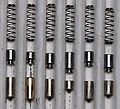BiLock EX
BiLock NG
| BiLock NG | |
|
File:BiLockNG.jpg | |
| Name | BiLock NG |
|---|---|
| Manufacturer | BiLock |
| Lock Type | Cylinder |
| Lock Design | Pin-tumbler, Sidebar |
| Year(s) Produced | Mid 1980s-present[1] |
| Patent | US 6,681,609 |
| Related Locks | |
| [] | |
The BiLock EG (or BiLock New Generation) is a UL 437-rated pin-tumbler lock made by BiLock. All BiLock models include two rows of pins and an associated sidebar for each row. The key is U-shaped to simultaneously register both rows of pins. BiLock keys are first cut, then folded to create their classic U-shape.
Principles of operation
The BiLock uses two rows of six pin-tumbler pins and five sidebar finger pins. To open the lock, all pin-tumblers properly raised to a height that allows the side bar legs to retract into small holes located in the key pins. Every pin has a second, shallow hole drilled in it. This hole is deep enough to allow the pin to set under sidebar pressure but too shallow to allow the sidebar to fully retract.
BiLocks are unique because they contain no driver/top pins and there the lock has no traditional shear line. There are ? depths for pin-tumblers, allowing for ? theoretical key differs for each pin stack. The MACS for this lock is ? depths, giving the ? around ? real key differs. Master keying is available by using pins with multiple sidebar holes.
The BiLock EG also has what is traditionally known as an interactive element in the key that was implemented to add an extra layer of security and extend the original patent of the lock. BiLock refers to this element as a "trigger" which is held between the two blades by the plastic key head. In its rest position the Trigger protrudes through a small opening in the key blade. As the key enters the keyway, the bottom of the keyway channel forces the front of the trigger upward into a lift pin. When the lift pin is raised, it drags a blocking bar up and out of the way of the right side bar, allowing it to retract.
To provide resistance against destructive entry, the 6000 uses ....
- BiLock sidebar.jpg
BiLock Sidebar.
Notes
Disassembly instructions
The 6000 is disassembled in the same way as a traditional pin-tumbler cylinder. The sidebar does not cause too many problems when the plug is removed. When the key is removed from the exposed plug the finger pins will be forced out by spring pressure.
- Remove the cam or C-clip.
- Insert the key and turn the plug 45-90 degrees.
- Withdraw the plug from the cylinder. (A plug follower is recommended)
OR
- Remove the chamber casings and take out each pin-stack individually
- Remove the cam or C-clip.
- Withdraw the plug from the cylinder.
Vulnerabilities
The 6000 system may be vulnerable to one or more of the following:
Notes
- Bumping is possible given a bump key with the correct sidebar bitting.

